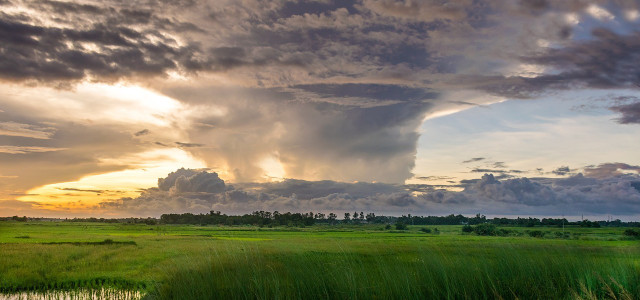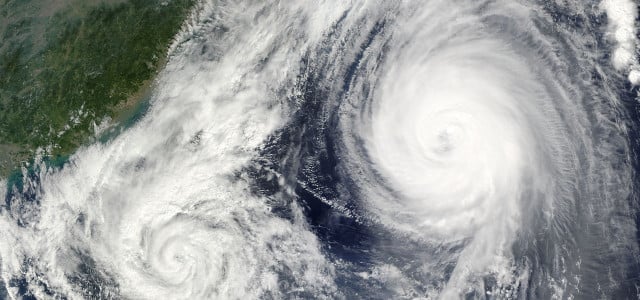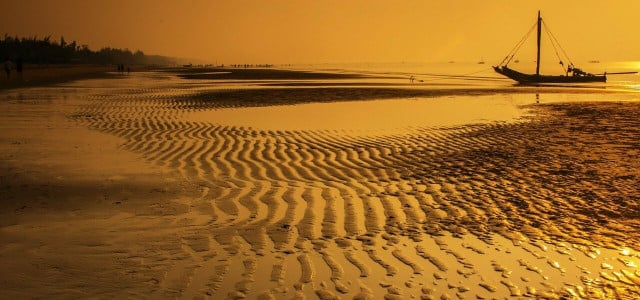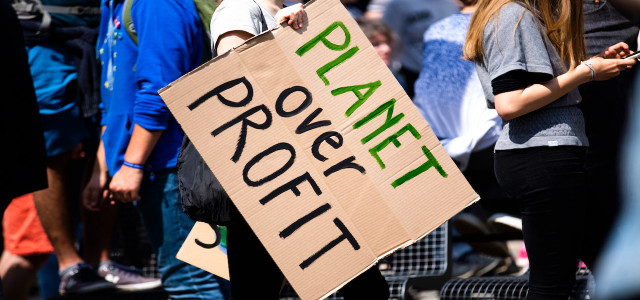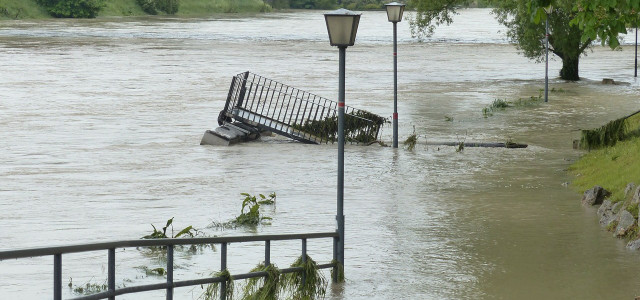They seem more relevant every day — but just what is a hurricane? Read on for the best hurricane definition and how they're affected by climate change.
What is a hurricane? A reasonably simple hurricane definition describes hurricanes as aggressive storms with the potential to cause widespread destruction and the loss of human life. However, scientifically speaking, hurricanes are much more than just storms. They are caused by various forces of nature — several of which are affected by global warming and climate change.
Some people fear that disasters like Katrina, Sandy and Ian will become more frequent and increasingly severe. Knowing a bit more about these tropical storms might help you understand why it’s crucial we adopt everyday ways to combat climate change.
Let’s take a closer look.
What Is a Hurricane?

(Foto: CC0 / Pixabay / janeb13)
If you’re looking for an official hurricane definition, the National Oceanic and Atmospheric Administration (NOAA) defines it as a tropical cyclone. Hurricanes must generate wind speeds of at least 74 mph to be classed as hurricanes. Several terms are used to describe these weather systems worldwide.
They’re called hurricanes in the North Atlantic Ocean and Eastern North Pacific. Meanwhile, they go by typhoons in the Western North Pacific — Japan, Philippines and China — and cyclones in the Western South Pacific and Indian Ocean.
As many Americans know from first-hand experience, hurricanes can be devastating and deadly. They are composed of three primary parts:
- The eye: the calm center of the hurricane. The eye is usually between 20-30 miles in diameter.
- The eyewall: this area surrounds the eye and is where the winds and rains are strongest. The horizontal inflow of air, or convergence, is so strong here that the air is lifted faster and with more force than anywhere else in the hurricane.
- Rain bands: these rotate outwards from the center and determine the storm size.
Hurricanes and typhoons continue to grow and intensify while traveling over the warm sea. They are directed and driven by light winds outside the storms themselves.
A storm system may be up to six miles high and 400 miles wide. When the system hits land, it does lose force — but its effect can still be devastating. Hurricanes and typhoons are just one reason to have your sustainable go-bag ready in case of disaster or evacuation.
Hurricanes are classified according to the Saffir-Simpson Hurricane Wind Scale. This useful scale ranges from categories one to five. Those ranking above three are considered major storms. A category five hurricane has wind speeds that exceed 157 miles per hour.
How Do Hurricanes Form?
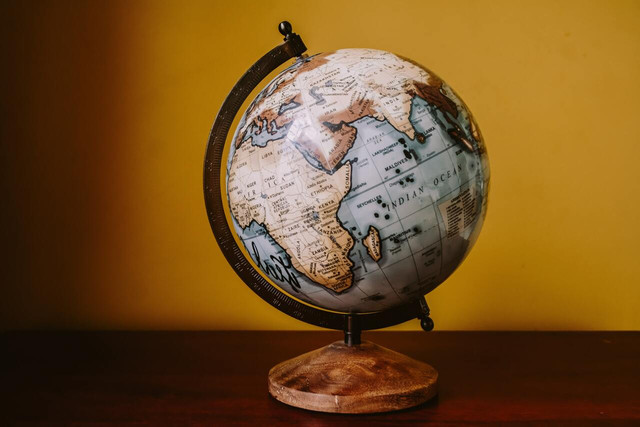


(Foto: CC0/ Unsplash/ Arpit Rastogi)
The following conditions must be present for a hurricane to form:
- An area of low pressure
- A source of warm, moist air from tropical oceans
- Winds near the ocean surface blowing from different directions
- Low wind shear (when winds change speed or direction over a short distance or time)
- Sufficient distance from the equator
- Weather disturbances (like thunder and lightning)
Coastal areas are usually the most brutally battered by the winds, rains, and storm surges hurricanes bring. However, hurricanes do not actually develop along the coast.
Hurricanes form in areas of low pressure over warm tropical and subtropical waters. Low-pressure areas are breeding grounds for well-organized storms because the atmosphere is thin and winds blow inwards from various directions. In areas of high pressure, the atmosphere is thick, and winds blow outwards — leaving little mechanisms for cloud and storm formation. In hurricanes, winds swirl and rotate around this area of low atmospheric pressure.
The Coriolis Effect
A broad zone of low pressure stretches from either side of the equator along the tropics. The winds on the north side of this zone blow from the northeast, and on the south side blow from the southeast. These winds are driven by the low-pressure core and Earth’s rotation or spin.
As Earth spins, places near the equator (middle of the planet) move much faster than those closer to the poles. Regions close to the equator must travel greater distances in the same period due to the planet’s spherical shape. These fast-moving equatorial regions are said to have angular momentum — a physics term concerning spin, movement and direction.
Objects moving on Earth’s surface appear to follow a curved path because of the planet’s spinning. This is known as the Coriolis force or the Coriolis Effect. This Coriolis Effect is why rockets are typically launched from areas near the equator, like Cape Canaveral in Florida.
We can explore space because the Earth’s rapidly spinning equator gives rockets a high initial speed, helping them get into orbit with the least possible amount of fuel. The Coriolis force also influences wind patterns and how ocean currents move.
That’s why hurricanes circulate counter-clockwise in the Northern Hemisphere and clockwise in the Southern Hemisphere. It also accounts for the different terms that refer to the same storm system, like typhoon, cyclone and hurricane. Hurricanes do not form further than 300 miles from the equator, as there is no Coriolis effect.
What Is a Hurricane? Forming Under Pressure
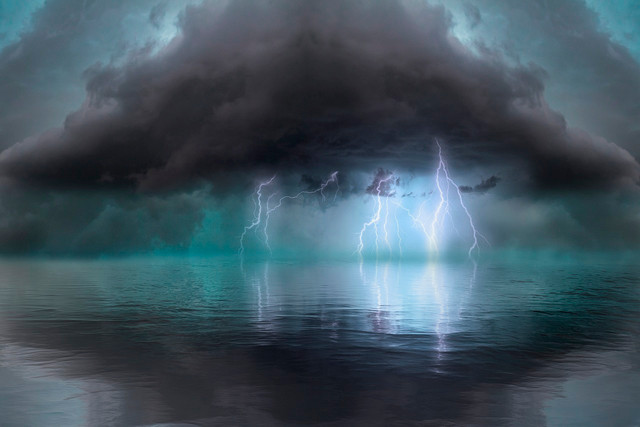


(Foto: CC0 / Pixabay / ELG21)
Air is heated within these tropical areas of low pressure over warm water. Warm ocean temperatures of at least 80 degrees Fahrenheit down to a depth of at least 50m and moist, humid air are essential for hurricane formation.
Heat in the water causes more evaporation and moist air, pushed up by winds blowing horizontally in opposite directions. The water content in the air forms the hurricane’s clouds and feeds it. Rapid cooling as the air rises releases heat to fuel the storm further.
The moist, warm air rotates upwards toward the cool low pressure. Air sinks at the center (or eye) of the storm. These and other mechanisms trigger thunderstorms. The showers usually come and go, but from time to time, they group into large clusters of thunderstorms. This provides the weather disturbance needed to form a hurricane. Add in the Coriolis Effect, and you’ve got a superstorm.
Hurricanes continue to grow and intensify while traveling over the warm sea. They are directed and driven by light winds outside storms themselves.
A storm system may be up to six miles high and 400 miles wide, moving at speeds as fast as 40 mph. When the system hits land, its effect can be devastating. Hurricanes are just one reason to have your sustainable go-bag ready in case of disaster or evacuation.
These massive storms bring the following destructive forces:
- Wind causing damage to homes, infrastructure, power lines and buildings, generating dangerous flying debris.
- Storm surges inducing sea levels to rise by as much as 20 to 30 feet as a storm reaches the coast, while wind hurls the ocean water towards land.
- Torrential rainfall leading rivers to burst and causing widespread flooding and mudslide formation.
'Tis The Season
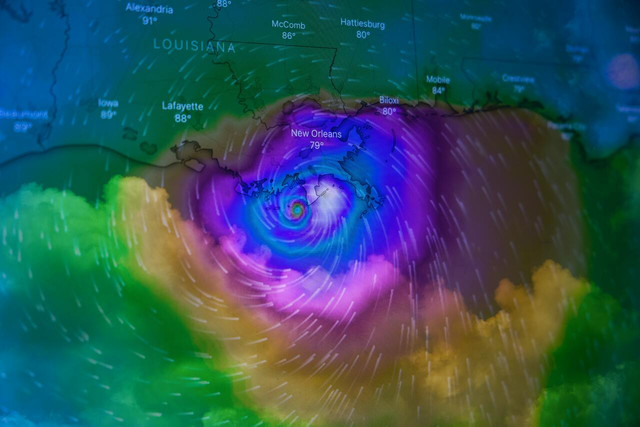


(Foto: CC0/ Unsplash/ Brian Mc Gowan)
There are differences between hurricane seasons around the world. This is because the actual seasons and tropical ocean temperatures are felt at various times in different regions.
- The Atlantic hurricane season runs from June 1 to November 30 and encompasses the Atlantic Ocean, Caribbean Sea and Gulf of Mexico. Most of the activity occurs between mid-August and mid-October, with September 10 often cited as the peak of the Atlantic season.
- The Southwest Indian Ocean season is officially from November 15 to April 30. Eighty percent of storms occur between December and March.
- The Southwest Indian and Australian/Southeast Indian basins have similar annual cycles, with the season beginning in late October/early November and ending in May.
- The Northeast Pacific basin hurricane season starts in late May or early June and continues until late October/early November, with a peak in storminess in late August/early September.
- The Northwest Pacific basin has tropical cyclones occurring all year round regularly. There is no official definition of hurricane season for this reason.
- The North Indian basin has peak activity in May and another peak in November. The official season goes from April to December.
- The Australian/Southwest Pacific basin tends to experience the beginning of its hurricane season with tropical cyclone activity in late October/early November. It peaks in late February/early March and fades out in May.
Hurricanes and tropical storms can happen before and after these dates; however, they’re infrequent.
What Is a Hurricane? Check Out These Hurricane Hotspots
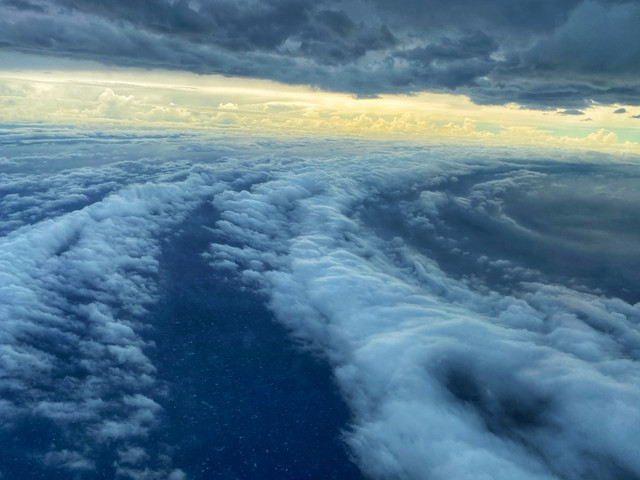


(Foto: NOAA/NGS)
The prime elements necessary for hurricane formation are often found in warm waters off the west coast of Africa. Hurricanes can also form in the Gulf of Mexico and the Caribbean. However, those starting close to Africa have thousands of miles of warm water ahead — and they gather energy as they travel. That energy helps them grow into powerful hurricanes.
Some hurricanes encounter cooler ocean temperatures that drain their energy or high wind shear that breaks them apart. That’s why tropical cyclones rarely hit northern states or Europe.
Wind currents set many tropical storms westward from Africa towards the Caribbean, Florida and the Gulf of Mexico. Some major hurricane hotspots include:
- Florida
- Texas
- North Carolina
- Louisiana
- Bahamas
- Cayman Islands
- Bermuda
- Nova Scotia, in Canada
- Cuba
According to the NOAA, after Florida, hurricanes hit most frequently in Texas, Louisiana, and North Carolina. Outside of the contiguous US, areas in the northern Caribbean like Bermuda, the Bahamas, Cuba, Puerto Rico, Haiti, the Dominican Republic, the US Virgin Islands and Mexico also see their fair share of hurricanes.
Memorable Hurricanes
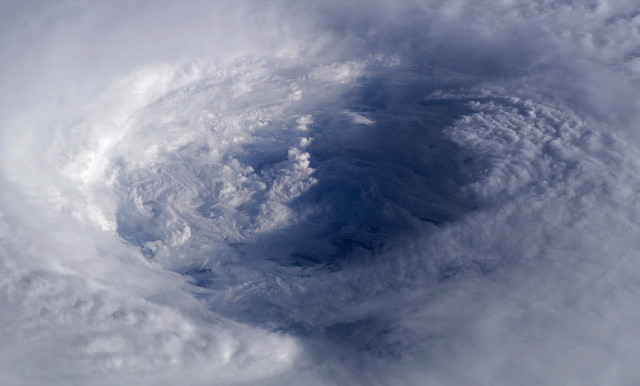


(Foto: CC0 / Pixabay / WikiImages)
The deadliest hurricane in history was the Great Hurricane of 1780. Over 20,000 people were killed, and buildings were annihilated when the monster storm swept through the eastern Caribbean Sea. The highest losses were seen on the Antilles islands of Barbados, Martinique, and Sint Eustatius.
The Galveston Hurricane of 1900 is considered the deadliest weather system to hit the US. It reached Cuba as a tropical storm on 3 September that year and swept through the Gulf of Mexico, where it intensified. By the time the storm reached the Texas coast south of Galveston, it was a Category 4 hurricane.
After landfall, Galveston tore through the Great Plains, the Great Lakes, New England and eastern Canada. Storm tides of 8 to 15 feet battered Galveston Island and the Texas coast. The estimated loss of life is between 8,000-12,000 — and damage is estimated at $30 million.
Mitch (1998) is the second-deadliest Atlantic hurricane on record. He devastated Central America. Floods, mudslides and wind destroyed Honduras’s infrastructure and crops. Parts of Nicaragua, Guatemala, Belize and El Salvador were also battered. The storm killed more than 11,000 people across Honduras, Nicaragua, Guatemala, El Salvador, Mexico and Costa Rica.
Isabel, in 2003, became the strongest hurricane felt in the Atlantic basin after Mitch. In the aftermath, a federal disaster was declared for 36 North Carolina counties.
Few will ever forget Hurricane Katrina, the hurricane that devastated New Orleans in 2005. The storm surge and flooding reaching 25-28 feet above average in Mississippi and 10-20 feet in Louisiana breached the levees and drowned New Orleans. Katrina led to 1200 deaths and damage of over $75 billion.
When Hurricane Sandy hit the Queens Borough of New York, it was a dark affair. The giant merged with another weather system to create an extra-tropical cyclone known as Superstorm Sandy. Sandy’s violent winds stretched over 900 miles and generated a 32.5-foot wave in New York Harbor. Sandy claimed 72 lives and left $65 billion in damage.
Hurricane Harvey dropped 51 inches of rain — approximately 20 trillion gallons of water — on top of Texas and Louisiana in 2017. Over 185,000 homes and buildings were destroyed. That same year, Hurricane Irma saw 585 shelters open throughout Florida and the death of 17 people in Florida, Georgia and South Carolina.
More recently, Hurricane Ian made landfall in 2022, first in Florida as a Category 4 storm and again as a Category 1 in Georgetown, South Carolina. Hurricane Ian tied for the fifth-strongest Category 4 hurricane ever to hit the US, with sustained winds of 150 mph. Ian caused the second-largest insured loss after Hurricane Katrina, inflicting $50-65 billion in damages.
Hurricanes and Climate Change
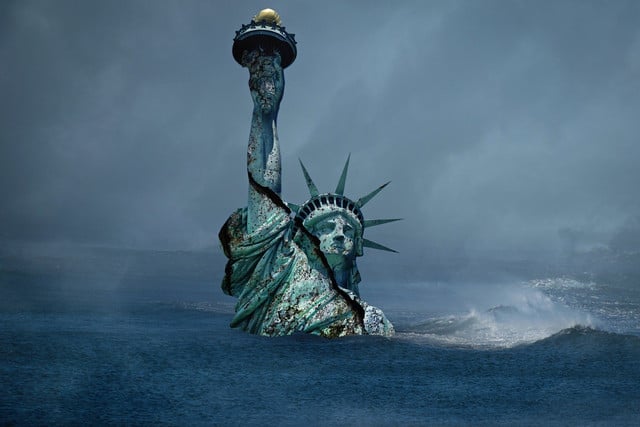


(Foto: CC0 / Pixabay / PhotoMIX-Company)
The temperatures of the ocean and atmosphere are critical to hurricane development. So what about hurricanes and climate change — what happens if the temperature keeps rising? The US saw 20 natural disasters in 2021 alone, including:
- One drought
- Two floods
- 11 severe storms
- Four tropical cyclones
- One wildfire
- One winter storm
As of 11 October 2022, there were 15 weather or climate disasters that year, causing over $1 billion in damage and destruction. These events included:
- One drought
- One flood
- 10 severe storms
- Two tropical cyclones
- One wildfire
The 2022 hurricane season saw Ian, Nicole and Fiona bring devastation and damage to Puerto Rico and the coast of Florida. Eight of 2022’s 14 tropical storms evolved into hurricanes.
Since the 1980s, hurricanes have been increasingly active in the North Atlantic, with more storms, stronger hurricanes and hurricanes that intensify rapidly. Despite this, the frequency of hurricanes actually making landfall in the US has not increased since 1900, despite significant global warming and the heating of the tropical Atlantic Ocean. In fact, the frequency of hurricanes is decreasing.
However, many experts, including NASA, warn that global warming will likely lead to more intense hurricanes making landfall more often, whether they increase in frequency or not. Some believe it that’s already happening. For example, some question whether Typhoon Merbok, which battered Alaska in September 2022, was exacerbated by unusually warm temperatures in the Pacific.
Research at Columbia Climate School focuses on hurricanes, climate change and the water cycle. Here’s what their research has found:
- The temperatures of the ocean and atmosphere are critical to hurricane development. A warmer ocean means more evaporation and water available in the atmosphere.
- Wind speeds will increase in a warming climate, and the number of storms that intensify into powerful Category 4 or 5 storms will also increase.
- Stronger storms increase the potential for higher storm surges. Furthermore, rising temperatures are causing the sea level to rise, which will mean more flooding.
Tom Knutson is a leading expert on hurricanes and climate change and a senior scientist at NOAA’s Geophysical Fluid Dynamics Laboratory. He agrees that even if climate change doesn’t increase the frequency and strength of hurricanes, the flooding from storm surge events will be made worse by sea level rise.
He and his team support the predictions made by NASA and Columbia. They also highlight that several models predict an increase in hurricane rainfall rates by the year 2100.
Finally, a 2019 study published in the online magazine nature shows significant increases in tropical cyclone intensification rates in the Atlantic basin. That’s highly unusual when compared to model-based estimates.
Whether the combination of global warming, climate change and hurricanes is propelling these changes remains uncertain. However, most experts are concerned.
Quick Facts
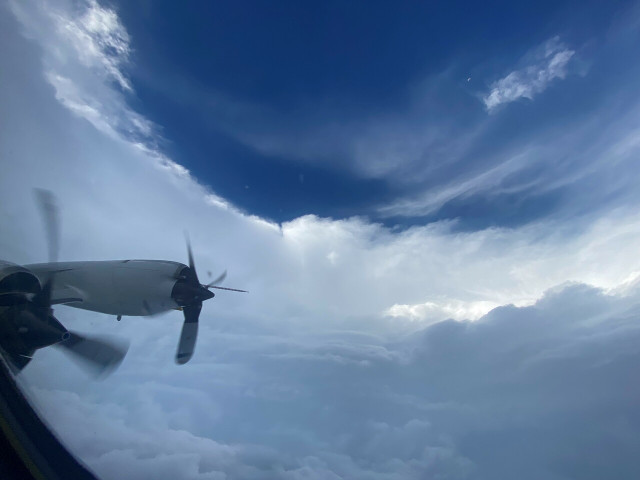


(Foto: NOAA/NGS)
Looking for some trivia and quick facts about hurricanes? Here you go!
- The first time anyone flew into a hurricane was in 1943, in the middle of World War II.
- When fully developed, a single hurricane can release heat energy equivalent to a 10-megaton nuclear bomb exploding every 20 minutes.
- Hurricanes help keep Earth’s temperature stable by moving heat energy from the equator to the poles.
- Hurricanes are the only weather disasters given their own names — a practice that began during World War II. Currently, names are chosen from six rotating lists of male and female names.
- No other planets have warm tropical oceans that form hurricanes. That said, gas giants like Jupiter and Saturn do experience similar storms.
- The word “hurricane” likely originated from the language of the Taíno, Indigenous peoples of the Caribbean. Their word, “hurucane,” referred to the evil spirit of the wind.
- Forty percent of all hurricane landfalls strike Florida, which so far in recorded history has seen 117 direct hits.
- What is a hurricane? Typically, a storm that generates wind speeds of at least 74 mph.
- Hurricanes can produce short-lived tornados.
- Hurricane Camille (1969) had the highest wind speed at landfall, at 190 mph, when it reached the Mississippi coast.
- Hurricane John holds the Guinness World Record for the longest-lasting hurricane, spanning a whopping 31 days. As it traveled from the eastern to the western Pacific, it became one of only a handful of hurricanes ever considered a hurricane and a typhoon.
Read more:
- Environmental Organizations: 8 NGOs and Non-Profits Worth Supporting
- Climate Change Denial: How to Stand Up To Skeptics
- 8 Things You Can Do to Save the Ocean
Do you like this post?






